How to Use Timers for Improved Productivity and Focus — Part 1
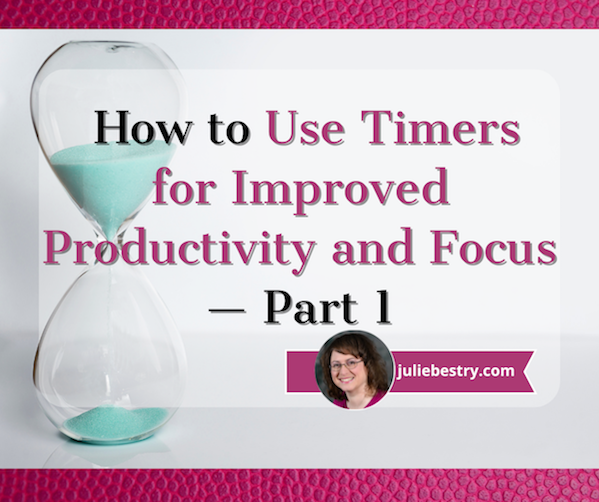
Everyone seems to agree that January slogged on, but people are shocked that we’ve suddenly arrived in April, with February and March having disappeared in the blink of an eye.
The truth is, most people aren’t very good at gauging the passage of time. In her A Working Library blog, Mandy Brown wrote Out of Time about writing, taking breaks, and resting. Prompted by another author’s piece about having gone on a retreat to find time to focus and recommending an analog timer (unsurprisingly, a Time Timer), Brown ordered one, but suffered frustration because she couldn’t get it to work. She kept putting in batteries and trading them out for others, finally ending the anecdote with:
I thought perhaps the timer didn’t like rechargeable batteries—some devices are persnickety that way—so I went rummaging around the house for a regular battery, found one in the toolbox, swapped it into the timer, turned the dial. And waited.
And waited.
Nothing.
I gave up, and went to fix lunch.
About a half hour later, as I was putting dishes away, I heard a steady beep from somewhere upstairs.
It was the timer, going off.
The damn thing had been working all along.
I just didn’t think it was working fast enough.
Time often fails to work as we think it should. It drags on, or it disappears. But of course, time is uniform; time is a constant. There are always 60 seconds in a minute, 60 minutes in an hour, 24 hours in a day, and so on. We are the ones with the problem, not time. We lack motivation and procrastinate. At first, the time available seems endless; then we panic and finally settle down, but allow ourselves to be interrupted, and the available time is suddenly gone.
In one of my most popular posts, Frogs, Tomatoes, and Bees: Time Techniques to Get Things Done, we looked at what we need to understand about our problematic time behaviors, and at nifty system solutions, including the Pomodoro Technique and its offshoots (Tocks, 90-Minute Blocks, 52/17 Method, and Flow State).
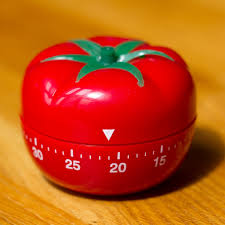
The exact number of minutes may vary, but the strategies remain the same:
- Do a brain dump to know everything you have to work on.
- Break large projects and concepts into smaller, distinct tasks so you can identify specific activities from which to choose.
- Prioritize what’s important to find the essential next task to tackle.
- Start that task and stay focused.
- Take a break. (Not sure how or why? Read Take a Break — How Breaks Improve Health and Productivity.)
- Lather, rinse, repeat.
Some methods may also involve noting what internal or external disruptions occurred. (Did you get hungry and wander off for a snack? Did a stray notification steal your attention and take you down a social media rabbit hole? Did your kids or co-worker need help finding something right in front of their eyes?)
To improve our use of time, we can incorporate short-term accountability, bringing in co-working buddies to body double and keep us focused and on-task.
- Paper Doll Sees Double: Body Doubling for Productivity
- Count on Accountability: 5 Productivity Support Solutions
- Flow and Faux (Accountability): Productivity, Focus, and Alex Trebek
Other methods involve giving ourselves rewards. Some digital apps support Pomodoro-based work using gamification, rewarding focus and completion. Maybe you’re not a carrot person but a stick person, and need a negative consequence for not sticking with it?
No matter your method, there’s one more commonality to all of these approaches: keeping track of time! And for that, we get the biggest bang for our buck by using timers.
WHY AND HOW TO USE TIMERS FOR PRODUCTIVITY
“C’mon, really?” clients ask, giving me the side-eye when I pull out one of my visual timers. “Can’t I just work until I get it done?”
Sure. Maybe. But probably not, especially if I’m not there with them.
If telling yourself to get down to work — and working a certain amount of time and not getting distracted but also not hyper-focusing to the point of getting burned out, eye strain, and a headache — actually worked for everyone, then time management wouldn’t be a “thing.”
Timers help us in all manner of ways, at work at and home. At its most basic, a physical timer or a visual digital timer/app creates a tangible representation of time passing so you can see and feel time.
Use Timers for Productivity at Work
You’re probably not shocked at the idea of using a timer, but you may feel silly employing one. Do you think that unless you’re a professional athlete, a surgeon struggling to perform a procedure within a safe time span, or a special effects master overseeing synchronization, that timers can’t help you?
There are many ways to improve your productivity at work with the help of timers.
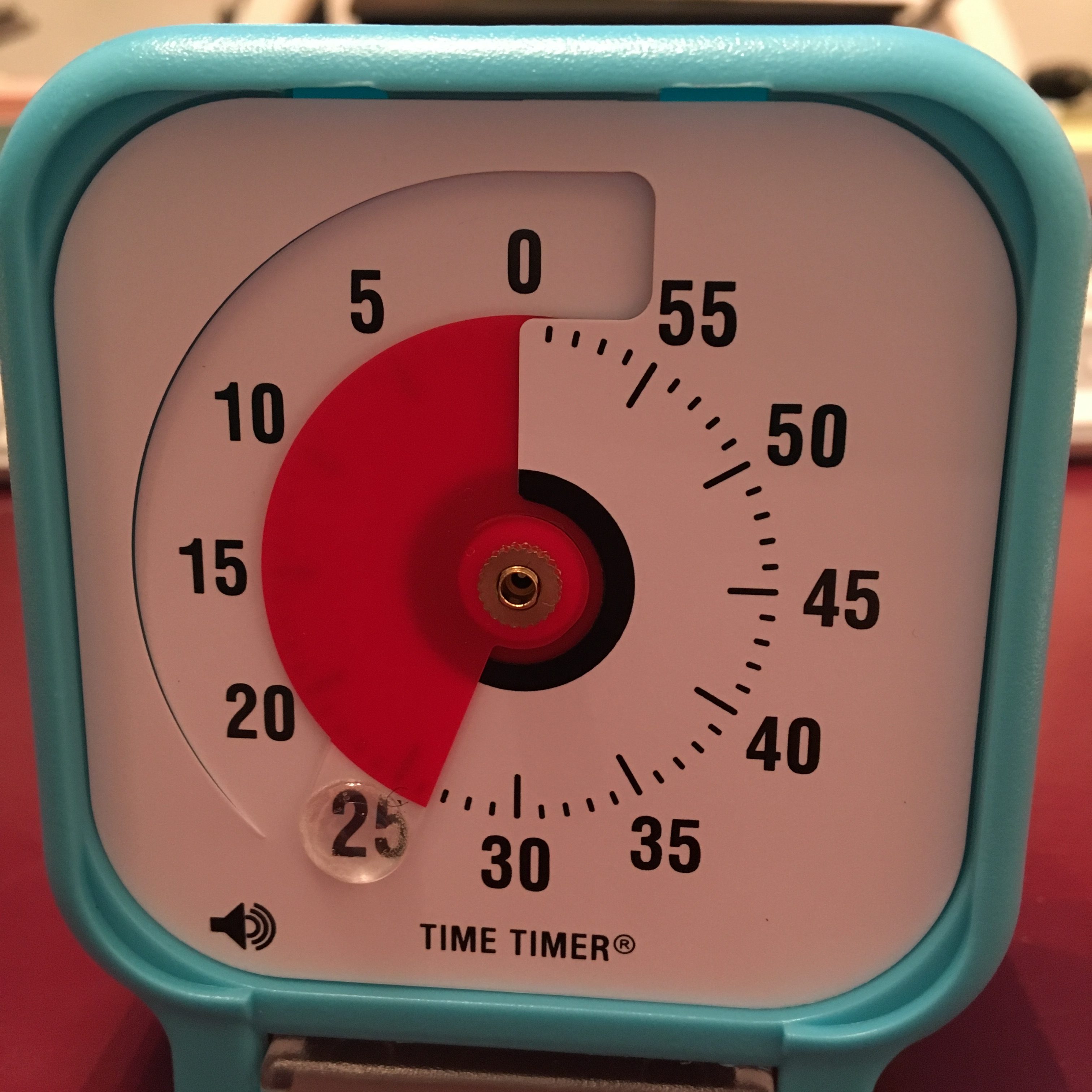
For yourself
- Avoid falling into the email rabbit hole — Set a timer so you don’t “come to” three hours later in the midst of an email-induced stupor, wondering why you just read an entire newsletter about artisanal butter when you were just looking for a sign-up email to send to your colleague.
- Time block your tasks like a pro — We’ve talked extensively about time blocking here at Paper Doll HQ. The only way to make sure you have time for all of your priorities is to schedule time on your calendar — the space where time lives — for attending to them.
But your calendar isn’t the only tool you need for time blocking. It tells you when you’re supposed to start a task, but how will you remember when to move to the next thing?
Want to tackle your bookkeeping and still have time for a snack? Set your timer, get it done, and reward yourself with something yummy like an apple. Or cheese. Or cookies. (As they say on TikTok, we listen and we don’t judge.)
- Prevent perfectionism paralysis — When societies were agrarian, we knew we were “finished” when we’d reaped the harvest; most modern work ends with deadlines — or (seemingly) never ends at all. Give yourself a hard stop on tweaking that PowerPoint so you don’t turn a simple deck into a TED Talk that nobody asked for. When the timer buzzes, you’re done. Move on with your day (and your life).
- Keep deep work from locking you in the deep freeze — You’re focused, you’re in the zone — until you look up and realize that it’s dark outside and you forgot to eat lunch or pick up your kid from soccer practice. A timer keeps you from pulling a Christopher Nolan-style time dilation.
For your team
- Prevent your meetings from dragging on like Martin Scorsese’s “The Irishman” (run-time: 3 hours and 29 minutes!) — Keep a visual timer in sight so everyone knows when the meeting should actually end, not just when it starts to improve satisfaction and engagement. Otherwise, the Monday status meeting begins to feel like a hostage situation.
If you’re the one moderating the meeting, install and set up the Zoom timer in the app:
- Add the Timer – Clock, Agenda, Countdown & Stopwatch to your paid Zoom account
- Using the Zoom Timer App
(Google Meet has a similar option you can add to the Chrome browser. While Microsoft Teams does not have a built-in timer, you can integrate third-party timers into a PowerPoint presentation or add one to the meeting itself.
- Help participants in your virtual meetings keep it snappy — Have you ever been on a Zoom call where someone talks in circles or drones on? Use a timer built into the screen and the meeting won’t devolve into a filibuster.
- Help team members segment their time for time tracking — Use timers to track how long tasks take and identify areas for improvement.
Having a timer go off (no more than) every thirty minutes or hour to prompt logging/tracking activities will help team members be more aware of how they spend their time, and make them (and you) less likely to get distracted by low-urgency, low-importance tasks. (For more on the benefits of time tracking, see my recent post, How to Use Time Tracking to Improve Your Productivity.)
However, it’s important that you don’t use timers to micromanage your team. A timer can be a powerful tool, but the moment you use it to time someone’s bathroom breaks or note that they come back from lunch two minutes after the buzzer, you’ve veered from Motivational Mama to Big Brother.
Use Timers to Improve Personal Time & Daily Living
- Keep your meals from turning into messes — The number one most common reason for using a timer at home is for cooking, and yet people really underutilize timers. Baking brownies? Sure, you’ll set the timer for 25 minutes. You know that it’s important to measure how long something should cook when there’s a recipe in the cookbook or the back of the box.
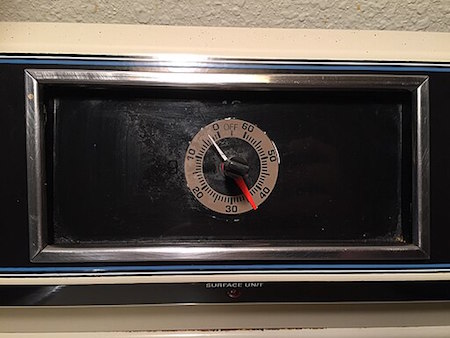
Kitchen Timer of HotPoint Electric Range, Steven Pavlov, CC BY-SA 4.0, via Wikimedia Commons
But how often do you set a timer to make sure you don’t get distracted and walk away altogether? Have you ever put the pasta in the boiling water or started the soup, only to get pulled away from the stove by your kids, a telephone call, a story on the news? Have you ever just turned your back on the stove to scroll through your feed and totally lost track of time until you heard the unmistakeable splish-splash of a pot boiling over?
It’s not really true that a watched pot never boils, but it is absolutely true that an unwatched pot boils over before you’re ready. And an monitored oven or air fryer will turn whatever you put in it into ash.
There’s a reason your microwave has a timer built-in. The manufacturers know that you’ll set a timer for something set to cook for a long while, but that you’ll overestimate your ability to get back in two minutes and forty seconds and completely forget that you were cooking.
If you’re not going to watch your food cook (and you are forgiven for not wanting to do that), set a timer. Use the timer built into your oven or just shout out, “Hey, Siri, set a timer for 7 minutes!”
And honestly, if you are sometimes so distracted that you don’t know why the alarm is going off, even if you set it fifteen minutes ago, you can say, “Hey, Siri, set an alarm for 7 minutes and call it ‘Pasta'” so that when you look at your phone to turn off the alarm, you’ll know what’s what.
- Save your laundry from shrinkage and wrinkleage — Modern washers and dryers have all sorts of bells and whistles. Well, bells and music, at least, with their deedle-deedle-ding musical trills as the washer changes cycles. However, if your laundry machines are in the basement and you’re on the second floor, you might not even hear those twinklingly annoying “dulcet” laundry tones.
And if, like me, you have a practical but not very modern washer/dryer set-up (the kind without myriad settings and just normal/delicate/heavy duty settings), your dryer may have one loud ear-splitting BUZZ to alert you that your clothes are dry and absolutely nothing (but the absence of white noise) to let you know that your washer is done. And again, if you’re not right by your laundry area, you may not even hear that.
But do you know what you always hear?
Your phone, because it’s never more than a foot away from you for long, and usually it’s within arm’s reach. Get to know how long your washer and dryer cycles are and create alarms for them: 17 or 35 minutes or whatever. Name the cycles something simple, like “Get clothes from dryer” or “Switch clothes from washer to dryer.”
The next time you start a load, just slide the toggle to ON and you’ll be alerted just about when your laundry is ready for you. This way, you’ll have no wet clothes sitting all night in the washer growing mold, and no set-in wrinkles from clothes that could have been folded or hung.
- Get a shower time reality check — Ever take a shower so long you accidentally turn it into a spa day?
A timer keeps you from running your water bill up like you’re auditioning for The Little Mermaid. An alternative to keeping a regular timer in your steamy bathroom is investing in a Bluetooth shower speaker connected to your cell phone, with an alarm set to play a favorite song. There are a lot of popular, inexpensive shower speakers that look something like this:

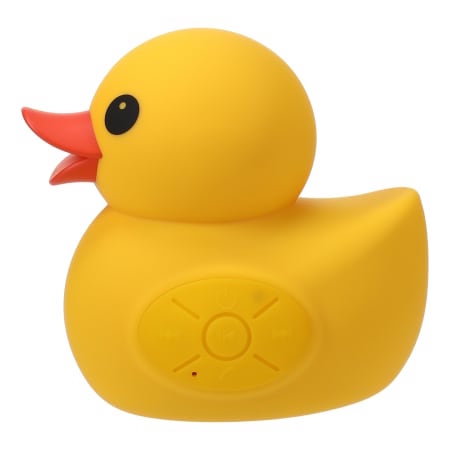




I get anxious when using a timer, but I can see its value for easily distracted clients. My kids use timers for laundry tasks. They set the dryer or washer and mark their timer with the time on the washer and dryer. Then, they know when to come down to do the next batch of laundry. Clever. Nowadays, our washer and dryer have an app that will notify you through Google Nest that the dryer/washer is finished. Timers can be used in various ways; thanks for sharing your advice.
I get the anxiety, especially if you feel like you’re running out of time. I prefer a timer I can see *when I want to look at it*, but is unobtrusive, like a TimeTimer, but I can understand how others prefer to be 100% in the moment and just be surprised when the timer goes off. This is part of what I’ll address next week in terms of customizing your timer choices to yourself.
Your kids ARE smart. I remember, in college, coming down over and over to check the dorm laundry room; I wish I’d thought of timers back then. And I had no idea that home washers/dryers had apps like that; brilliant! (I do know that public laundry rooms, both in dorms and in apartment complexes, connect to apps so you can see whether there are any washers/dryers available; I don’t know if they also show you when your laundry is done, but that would be cool!)
Thanks for reading!
I use alarms and timers all of the time. I love my time timer on my desk and use my phone for alarms (10 min. before a Zoom meeting or a need to leave for a client) and timers (for cooking and rest breaks). In the kitchen I may use my microwave timer and my phone timer for 2 different items I am preparing but even then, I can confuse myself – was that timer for checking the oven or for draining the pasta?
I know I have a lousy sense of time so I use every prompt I can find.
Given the cool cards that you and Diane invented, I am not surprised to know that you use timers, and I’m sure “10 minutes” is your favorite interval!
And your example is exactly why I teach clients to create labels for their timers, so they can see on their phones what the timer was for. Timers are magical and we SO underutilize them!
Thanks for reading!
OK, so for the sake of argument, let’s say someone has an adult-ish son with ADHD who says he ignores his timer going off. Like all the time. Any and all advice from his mother is deemed in admissible in the court of his mind. How about some thoughts from a brilliant outsider?
Ignores it, as in it just keeps playing and he doesn’t hear it? Then the timer sound needs to be at the highest possible volume, and then something he finds incredibly annoying. So, (and as much as I love him) Barry Manilow might be the right choice, vs. the sound of a jackhammer or punk rock if the person needing the timer is 70.
A bigger problem is that people will swoosh away their alarms without thinking. For them, the alarm needs to be across the room. Next week, we’ll talk about the right timers for the right people, and I’ll expand upon your great question…for the sake of argument. 😉
There are so many beefy ideas here.
First, my dryer makes me laugh because it plays a tune that my daughter actually sang as her audition piece for college. Who knew I would become so familiar with Die Forella?
The doomscrolling is a bad thing at all times. Definitely at bedtime, but pretty much anytime. I think a timer is so helpful to boundary this activity. It’s like we need one timer that is simply for this, to put a limit on how much time we waste. I like the idea of the TimeTimer because it helps me see how much time I’m wasting.
I’ve found with children that a playlist can also be a timer. For instance, you start the playlist when you wake the children up (the same one, every day). Over time, they get used to hearing the order of songs, and know that when a specific one comes in, it is almost time to leave. Great idea, right?
We used to count our car rides in how many “Arthurs” (which meant, episodes of the cartoon Arthur) the trip would be. Not that we watched Arthur for the whole trip (this wasn’t even an option back in the dark ages), but it helped my children understand whether the trip would be long or short.
It is interesting how we easily embrace timers for cooking, but don’t think to use them for other activities. Great post!
I love that I got the Seana Stamp of Approval!
Do you have a Samsung? Did you know that Die Forella means “The Trout?” Her audition piece, by Schubert, appears to be about a fish caught by a fisherman, until the final stanza, when you learn it’s a cautionary tale for women to watch out for men! Who knew?! I bet Samsung doesn’t!
The doomscrolling thing is serious. On TikTok, there’s a lady who comes on and whispers, “You’ve been scrolling for a while. Do you want to take a break?” And yes, I do, but I can’t bring myself to do it! Some apps let you set a timer to shut off your access after an hour; it’s like parental controls, but you’re parenting yourself!
YES! BONUS POINTS for the playlist idea! Each song triggers an activity. I might steal that (and give you credit, of course), in a future post. And the Arthur episodes idea is a great way to help kids understand and “feel” how time passes.
Thanks so much for reading and sharing your thoughts!
I’m not sure when it happened, but at some point in my adult life, I started loving timers—or, more correctly, I started to appreciate using them. Now, I can’t live without them.
The overarching value of using timers is that I love to hyper-focus and be present with what I’m doing. However, my ability to simultaneously be time-aware disappears when I’m hyper-focusing. And while that might be OK when I’m on vacation or have no scheduled commitments, I need to be aware of where my time is being focused for most of the year.
I regularly use the Time Timer for meetings and workshops and my Clock timer app on my iPhone. Recently, I learned two new tricks. I can ask Siri to set a timer for me. I can also use the Clock app to set a timer and label what it’s for. That feature is beneficial when cooking multiple things with different ‘check’ times.
Well, you appreciate timers, then I’m glad I wrote this post!
And yes, having Siri set the timer and label it is what I was getting at in the paragraph where I said you can say “Hey, Siri, set an alarm for 7 minutes and call it “Pasta”” — letting your clock app and Siri be your sous chefs can make all the difference!
Thanks for reading!
I have built in timers (as in a very good sense of time) and I pay close attention to how long things take me to do.
I use the playlist idea with clients needing to do mundane tasks. They create a playlist of 30 minutes or so. It must be of upbeat, lively music to keep them energized. As they get used to the list, they recognize when their time doing the boring task is almost up and it motivates them to do just a little bit more.
I’m very interested to read the next installment.
I love everything to do with time. It’s our most precious commodity, the most misused, and the commodity many people don’t work hard enough to use wisely.
I love the lyrical way you write and think about time, Diane. We’re kindred in that way. Working in TV for as long as I did, I honed a keen sense of time; I can watch an act of a show, see how the scenes are cut, and know how much time has passed. And I do the same as you with clients (and for myself) to encourage focus, but also combat hyper-focus when there’s something really compelling to read, write, or watch. I hope you enjoy the next installment.